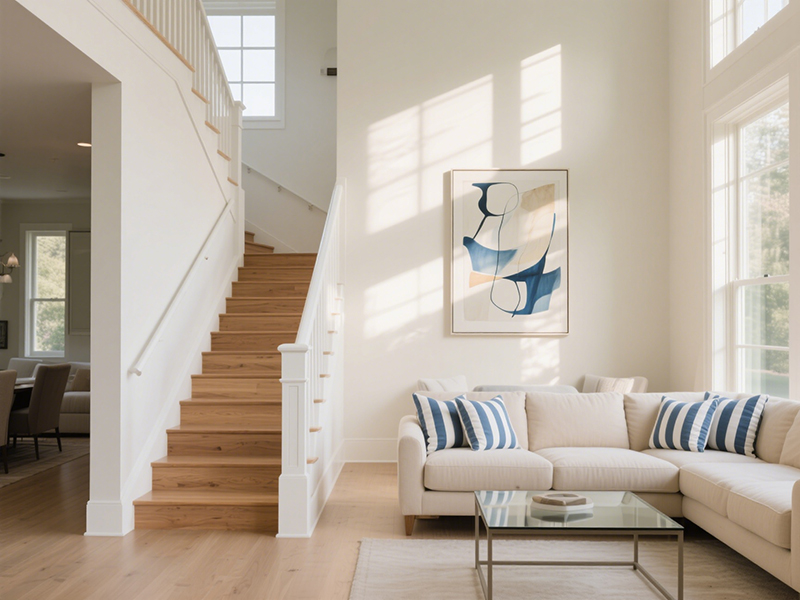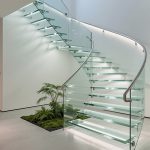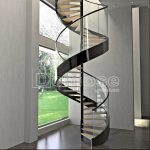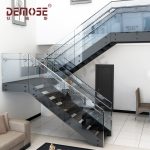Staircases are among the most hazardous areas in homes, accounting for over 1 million injuries annually in the U.S. alone. While aesthetics often dominate staircase design choices, compliance with safety regulations remains critical for preventing falls, especially for children, seniors, and individuals with mobility challenges. This article outlines key residential staircase safety standards based on the International Residential Code (IRC), ADA guidelines, and British Standard BS 5395-1.

I. Dimensional Compliance: The Foundation of Safety
Tread and Riser Specifications
- Riser Height: Must not exceed 7¾” (19.7 cm) with ≤3/8″ (9.5 mm) variation between steps (IRC R311.7.5)
- Tread Depth: Minimum 10″ (25.4 cm) measured from nosing to nosing (IRC R311.7.6)
- Nosing Projection: ≤1¼” (3.2 cm) with radius ≤9/16″ (14.3 mm) to prevent tripping
Safety Rationale: Inconsistent step dimensions are the leading cause of missteps. A ¼” (6 mm) deviation increases fall risk by 27% (National Safety Council data).
II. Handrail Engineering Requirements
Geometry and Accessibility
- Height: 34″-38″ (86-97 cm) vertically from tread nosing (ADA 505.4)
- Diameter: 1¼”-2″ (3.2-5 cm) for comfortable grip
- Continuity: Must extend 12″ (30.5 cm) beyond top/bottom steps
Structural Integrity
- Withstand 200 lbs (90.7 kg) of downward/outward force (ICC/ANSI A117.1)
- 1½” (3.8 cm) clearance between wall and handrail

III. Guardrail and Baluster Standards
Baluster Spacing
- Maximum 4″ (10.2 cm) sphere cannot pass through (to prevent child entrapment)
- Glass infill panels (if used) must be tempered ≥1/4″ (6 mm) thickness
Guardrail Height
- Minimum 36″ (91 cm) for landings/open sides (IRC R312.1.1)
- 42″ (107 cm) recommended for stairs with >10′ (3 m) vertical drop
VI. Critical Lighting and Visibility Factors
Illumination Requirements
- Minimum 10 lux at tread surfaces (CIBSE Lighting Guide LG07)
- Contrast ratio ≥30% between treads and risers
- Nightlight integration (0.5-1 lux) for nighttime visibility
Anti-Slip Solutions
- Slip Resistance: Wet Dynamic Coefficient of Friction (DCOF) ≥0.42 (ANSI A326.3)
- Nosing Identification: Abrasive strips or photoluminescent markings

V. Special Considerations for Vulnerable Groups
Child Safety
Install self-closing safety gates (ASTM F1004 compliant) at top/bottom
Avoid horizontal balusters that could facilitate climbing
Aging-in-Place Modifications
Dual handrails (34″/29″ heights) for varied user needs
Tactile warning strips at stair approach zones
VI. Maintenance and Inspection Protocols
Conduct quarterly inspections focusing on:
- Loose handrail brackets (torque to ≥25 ft-lb/34 N·m)
- Cracked treads (>1/8″ width requires immediate repair)
- Corrosion (replace components showing >10% cross-sectional loss)

Common Code Violations to Avoid
- Open risers exceeding 4″ sphere passage
- Missing intermediate handrails on wide stairs (>88″/223 cm)
- Inadequate headroom (<6’8″/203 cm clearance)
- Improper spiral staircase dimensions (tread depth <7½”/19 cm at 12″ from narrow end)
Conclusion
While local building codes may vary, these universal principles form the baseline for safe residential staircase design. Modern solutions like pressure-sensitive alert systems (detecting falls within 0.3 seconds) and smart handrails with emergency call buttons now integrate safety with technology. Always consult certified professionals for renovation projects, as 68% of DIY stair modifications fail to meet code requirements (Home Safety Council Report 2023). Remember: A compliant staircase isn’t just legally prudent—it’s a fundamental investment in household well-being.




